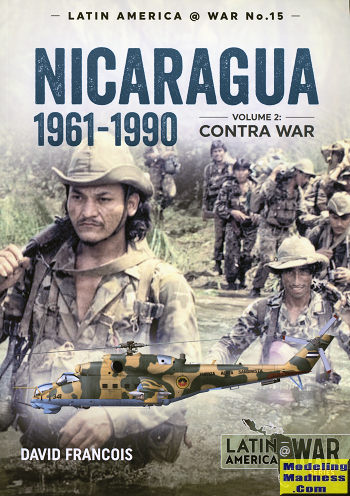 If you
recall from a while back, I reviewed the first volume on the conflict in
Nicaragua which dealt with the ouster of the US backed dictatorship of Somoza
and the replacement of his government with the Sandinistas, who were more
aligned with the ideals of Cuba and the Soviet Union.
If you
recall from a while back, I reviewed the first volume on the conflict in
Nicaragua which dealt with the ouster of the US backed dictatorship of Somoza
and the replacement of his government with the Sandinistas, who were more
aligned with the ideals of Cuba and the Soviet Union.
As it often the case with regime change, the populace
was happy about the situation as the Somoza government had been quite corrupt
and the state police, the Guardia Nationale were brutal in their suppression of
anything that the Somoza government did not like. However, the new Sandinista
governemtn was not able to make the worker's paradise that was initially hoped.
Their break-up of the large plantations wasn't very popular with the owners and
general treatment of the bourgeoisie did not go over well at all.
In Nicaragua, most of the major cities are on the
Pacific coast side of the country. The Atlantic/Caribbean side was fairly poor
and home of most of the indigenous population. It was also fairly autonomous and
rarely bothered by the previous government. However, the Sandinistas wanted to
integrate this area into the rest of the nation, a move that found little favor
with the locals.
So when you add in the displaced wealthy and middle
class along with unhappy peoples from the poorer side of the nation, you get
what eventually became to be known as the contra-revolutionaries, or the
Contras. These were an amalgamation of various groups, quite similar to the
original revolutionaries of the 1950s, but not as well organized or as well
funded.
Indeed, during the years up to the end of the Contra
war, their main funding came from the US. However, it was sporadic in nature and
was never really sufficient to allow the sort of efforts that were needed. It
was helpful that both Honduras and Costa Rica were sympathetic to these groups
and allowed them bases in their countries from which to operate, but in the end,
even that was taken away when the political climate changed.
Considered one of the three 'hot' wars of the Cold War,
the conflict in Nicaragua was, as is often the case, quite a complex weaving of
situations and actors, with their fortunes rising and falling based as much on
external forces as anything else. In the end, the Sandinistas had the men,
equipment and training to eventually win out. However, the cost, in both money
and politics were enough to nearly bankrupt the nation and even today, Nicaragua
has not been able to fully recover and is one of the poorest nations in Central
America.
As is often the case in this series, the author has done
a magnificent job straightening everything out for the reader so that we can
follow not only the twists and turns on the ground, but also in the political
arena. This latter area is just as important to the story as anything else, and
often the most difficult to understand. When you add in the great period photos,
excellent charts and maps along with a nice selection of color work on men and
equipment, you have a book that makes for a great read.
This one is very much recommended to those who have an
interest in this sort of conflict or this part of the world. Pick it up. You
won't be disappointed.
March 2020
Copyright ModelingMadness.com
Review book courtesy of
Casemate Publishing, where you can order your copy
at this
link.
If you would like your product reviewed fairly and quickly, please
contact
me or see other details in the
Note to
Contributors.
 If you
recall from a while back, I reviewed the first volume on the conflict in
Nicaragua which dealt with the ouster of the US backed dictatorship of Somoza
and the replacement of his government with the Sandinistas, who were more
aligned with the ideals of Cuba and the Soviet Union.
If you
recall from a while back, I reviewed the first volume on the conflict in
Nicaragua which dealt with the ouster of the US backed dictatorship of Somoza
and the replacement of his government with the Sandinistas, who were more
aligned with the ideals of Cuba and the Soviet Union.